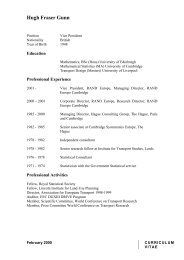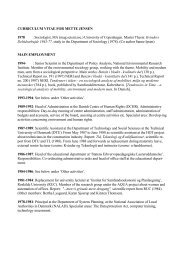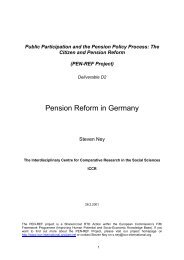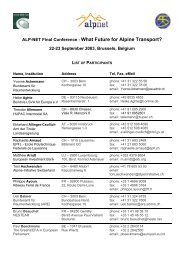The Housing Dimension of Welfare Reform - the ICCR
The Housing Dimension of Welfare Reform - the ICCR
The Housing Dimension of Welfare Reform - the ICCR
Create successful ePaper yourself
Turn your PDF publications into a flip-book with our unique Google optimized e-Paper software.
<strong>The</strong> implications <strong>of</strong> our logistic regression analyses can be summarised<br />
as follows:<br />
1. Both <strong>the</strong> entry into and exit from poverty is across countries clearly<br />
related to variables which represent socio-economic position, housing<br />
and deprivation.<br />
2. Each <strong>of</strong> <strong>the</strong> above variables has its own independent contribution to<br />
<strong>the</strong> risk <strong>of</strong> entry into and <strong>the</strong> likelihood <strong>of</strong> exit from poverty.<br />
3. Work attachment <strong>of</strong> <strong>the</strong> household is <strong>the</strong> single most important<br />
variable.<br />
4. <strong>The</strong> probability <strong>of</strong> a poverty transition increases when several risk<br />
factors cumulate. Interactions are however present, particularly on <strong>the</strong><br />
country level.<br />
5. <strong>The</strong> risk to enter poverty is widely dispersed and broader parts <strong>of</strong> <strong>the</strong><br />
population may experience a transitory phase <strong>of</strong> poverty. Once poor<br />
<strong>the</strong> exit chance will however strongly depend on <strong>the</strong> length <strong>of</strong> <strong>the</strong><br />
experience <strong>of</strong> poverty and on how <strong>the</strong> individual or household<br />
manages to cope with structural barriers or constraints.<br />
6. <strong>The</strong> housing situation does not appear to be a form <strong>of</strong> capital which<br />
can support an exit, it is, however, related with different entry risks.<br />
Characteristics <strong>of</strong> persistently poor<br />
By far <strong>the</strong> most robust finding with regard to persistent poverty is that it<br />
is strongly associated with <strong>the</strong> lack <strong>of</strong> resources and, in particular,<br />
inactivity and/or <strong>the</strong> lack <strong>of</strong> integration into <strong>the</strong> labour market. This is<br />
true across Europe and in most European countries: <strong>the</strong> unemployed, <strong>the</strong><br />
inactive and, more generally, those living in households where <strong>the</strong> work<br />
intensity is zero or very low are between three to five times more likely<br />
to slip into persistent poverty than those who work. Not surprisingly <strong>the</strong><br />
level <strong>of</strong> educational achievement in a household is as important a<br />
protection against persistent poverty – <strong>the</strong> highest <strong>the</strong> combined<br />
educational level in a household <strong>the</strong> less likely is unemployment and<br />
hence persistent poverty.<br />
All o<strong>the</strong>r findings about risk groups and persistent income poverty<br />
display a strong country variation:<br />
In most countries <strong>the</strong> retired do not face a higher than average risk <strong>of</strong><br />
persistent poverty. This is an interesting finding, especially considering<br />
that persons <strong>of</strong> pension age are among <strong>the</strong> risk groups for temporary or<br />
one-time poverty. This suggests that entry into pension, associated as it is<br />
for most with a significant decrease <strong>of</strong> monetary resources, may lead to<br />
EUROHOME-IMPACT FINAL REPORT 41









